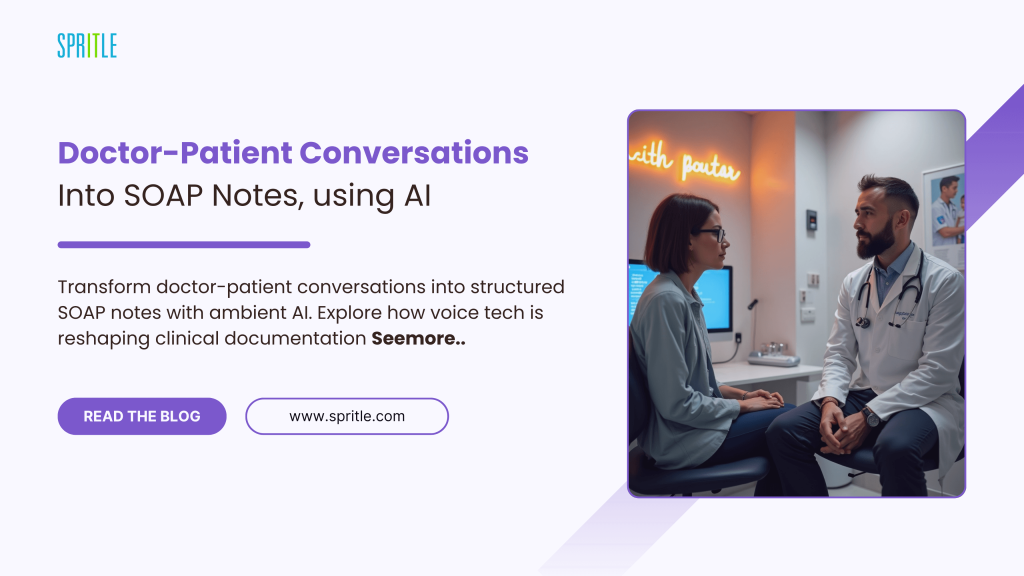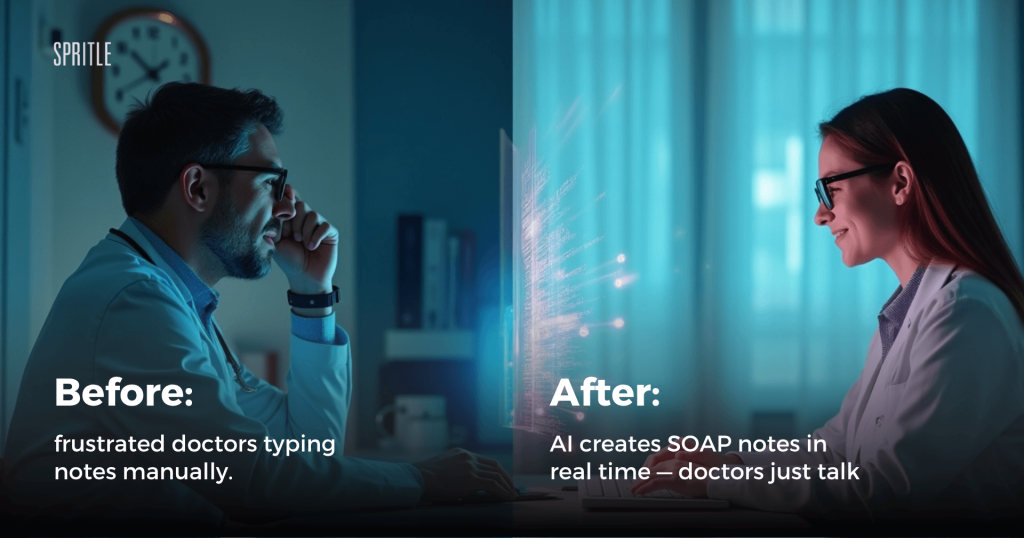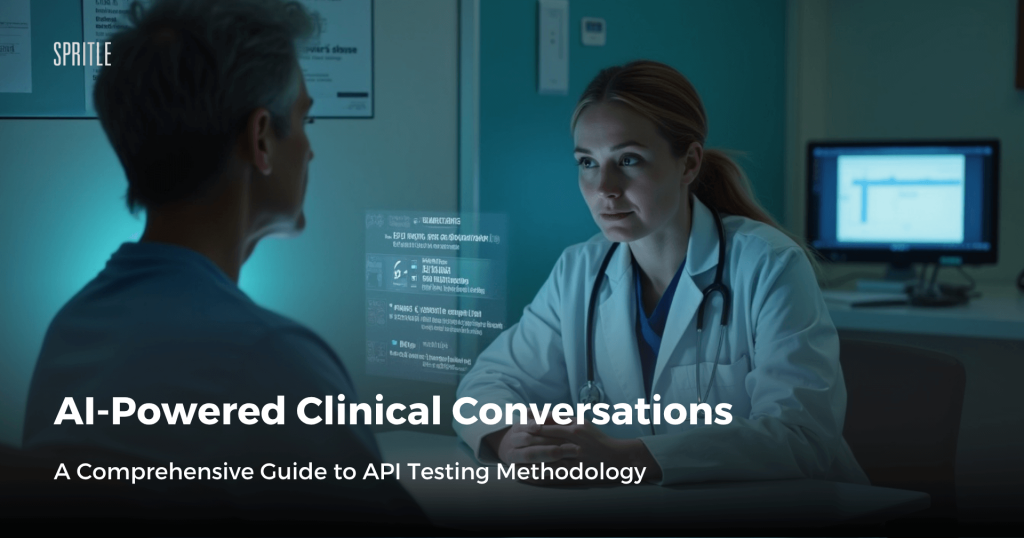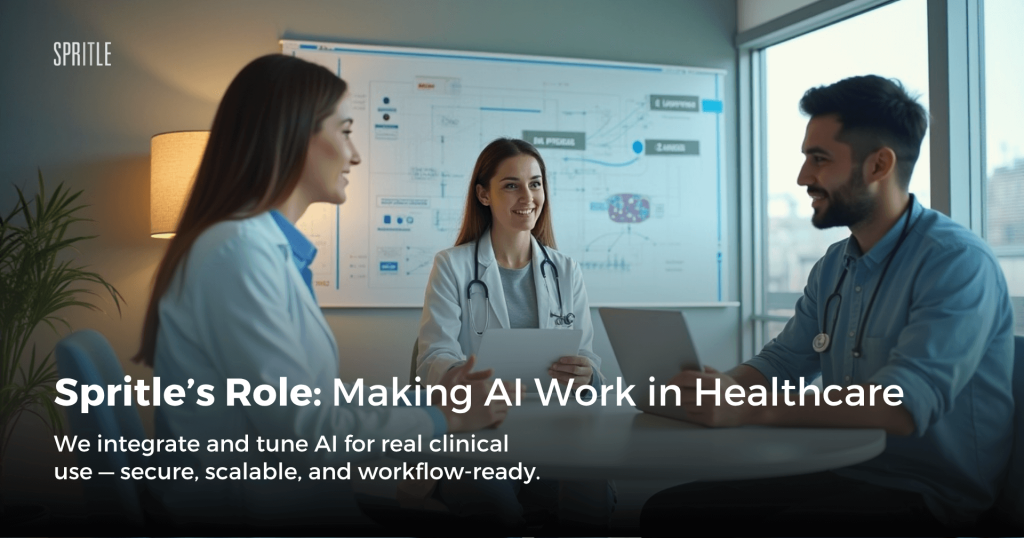
How ambient AI and real-time voice tech are reimagining clinical documentation and what it really takes to make it work
It’s 10:47 PM. The hospital floor is finally quiet. The last patient has been stabilized, the halls are empty, and the doctor exhausted but dutiful is still typing. Her shift ended over an hour ago, but the screen glows on, cursor blinking as she dictates medical notes from memory.
This isn’t an isolated story. Across clinics, hospitals, and private practices, highly trained professionals are spending hours on documentation time that could be spent with patients, families, or simply resting.
Now imagine a different scene.
The same doctor finishes her consultation and speaks naturally with her patient. No typing. No scribe in the corner. Just conversation. And yet, behind the scenes, AI listens. It understands. It processes the interaction and neatly writes the chart, files the note, codes the billing entry, and suggests follow-up actions – all in real time.
Welcome to the future of medical documentation.


From Keyboard to Conversation: The Shift That’s Already Here
Voice has always been part of medicine – doctors talk to patients, dictate notes, leave voicemails, and relay instructions. What’s new isn’t the presence of voice, but the rise of ambient intelligence: AI systems that listen passively, interpret context, and generate structured clinical content without active input from the clinician.
Major players like Nuance’s DAX, Augmedix, and Nabla are pushing the frontier with real-time medical scribes powered by AI. These tools leverage advances in speech recognition, natural language processing (NLP), and contextual AI to convert conversations into rich, coded medical records.
But the real revolution isn’t just in transcription. It’s in understanding. These systems go beyond capturing what’s said — they interpret intent, identify medical concepts, and apply structured logic so that the resulting notes are not just accurate, but actionable. Think of it like moving from a tape recorder to a smart assistant who understands clinical nuance.
Why It’s Not Just Plug-and-Play (Yet)
If this sounds like science fiction or magic it’s not. But it also isn’t an out-of-the-box miracle. That’s where many healthcare leaders get tripped up.
Yes, these tools are powerful. But real-world implementation involves:
Tuning for clinical specialties: A pediatric practice speaks differently from a cardiology clinic. AI needs contextual awareness.Navigating HIPAA and security protocols: Voice data is sensitive. Transmission, storage, and access controls must be airtight.Seamless integration with EHR/EMR systems: If your AI-generated note can’t land directly in Epic, Cerner, or Athena — you’re back to square one.User experience and workflow fit: AI must blend into daily routines. If it adds friction, it fails.
This isn’t to dissuade adoption — it’s to highlight a critical truth: Healthcare AI isn’t a product, it’s a system. And that system needs architects, not just vendors.
The Human-AI Co-Pilot Model: Why AI Won’t Replace Clinicians (But Will Empower them)
One of the biggest myths about AI in healthcare is that it’s coming for clinicians’ jobs. The reality couldn’t be more different.
AI scribes aren’t replacing physicians — they’re acting more like co-pilots, quietly handling the controls of documentation so the doctor can focus on flying the plane. In this model:
Doctors lead the careAI captures the contextSpecialists (like Spritle Software) handle the translation between clinical reality and technical infrastructure
And this isn’t limited to large hospital systems. Even mid-sized practices, specialty clinics, and digital health startups are beginning to realize that ambient AI can be a competitive advantage – if implemented correctly.


Spritle’s Role: Making the Futuristic Practical
At Spritle Software, we’re not building the voice AI model from scratch and neither should you. Instead, we help healthcare teams:
Choose the right stack (based on needs, specialty, and compliance)Customize the implementation to fit real-world workflowsConnect the dots between AI outputs and your EHR systemsEnsure ongoing privacy, security, and performance tuning
Think of us not as salespeople pushing a tool, but as your strategic partner navigating a complex shift in how healthcare gets documented. We’re the ones who ask: “Will this still work at scale? What about in a high-noise emergency room? Can it distinguish a drug name from a symptom?”
In other words, we help ask the questions most demo videos skip.


The Danger of Demos: Don’t Be Fooled by the Sizzle
It’s easy to fall in love with an AI scribe demo. A polished voice assistant transcribes a conversation perfectly, structures the note, and ends with applause.
But what happens in the real world?
There’s background noise.There are patients with heavy accents.There’s code-switching between clinical and conversational language.There are legal and billing implications for every word captured.
DIY setups or plug-and-play platforms rarely account for these layers. It’s like buying a Tesla without a charging station impressive machine, no infrastructure. That’s why asking the right questions is more important than getting the right features.
Starbucks Scribbles vs. Structured Notes
Let’s break it down with a metaphor.
Think of AI note capture like writing names on coffee cups at Starbucks. Anyone can scribble something. But what clinicians need are polished, legally sound, EHR-compatible documents not coffee-cup shorthand.
Voice-to-text isn’t enough. It’s the AI interpretation layer, the domain adaptation, and the downstream system sync that makes the difference.
And that’s where a team like Spritle becomes the bridge between cool tech and clinical utility.
What’s Coming Next: Voice-First Healthcare
We’re standing at the edge of a new paradigm: Voice-first healthcare.
Soon, clinical rooms may not have keyboards. Instead, they’ll have ambient AI systems quietly listening, securely processing, and continuously learning. Notes will be written in the background, prescriptions pre-filled, referrals drafted all triggered by natural dialogue.
But we’re not quite there yet. Today, voice-AI in healthcare is promising, but delicate and it needs careful tuning to deliver value without friction.
A Vision Worth Building
Imagine a world where:
Doctors go home on timePatients feel truly listened toClinicians don’t burn out over admin tasksAI handles the mundane while humans handle the meaningful
That’s not just good technology. That’s better healthcare.
At Spritle, we believe the future isn’t about replacing people — it’s about giving them time back. Time to care. Time to think. Time to be human again.
Curious? Good.
If you’re a product owner building a healthtech platform, or a clinical leader considering AI for documentation, we encourage you to be skeptical and curious. The tools are powerful. But power needs guidance.
Ask the hard questions. Look beyond the demo.And when you’re ready to make the futuristic practical, we’re here to help.



